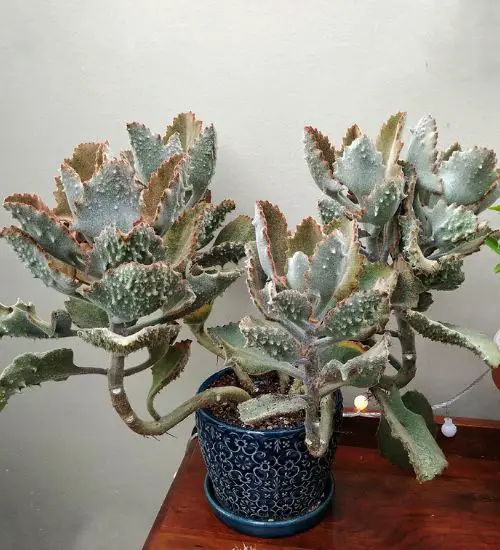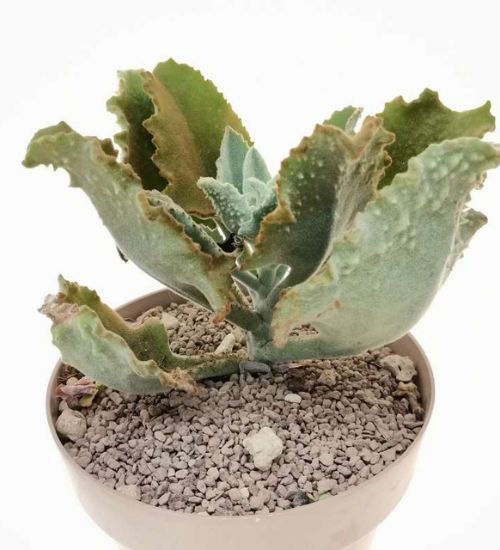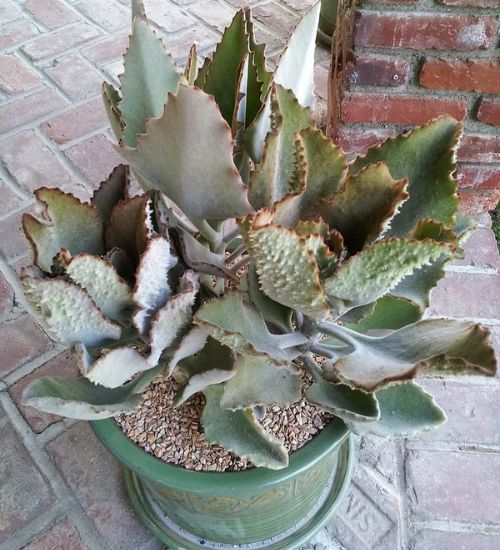Sun: full sun to partial shade
Water: Typical water needs for a succulent
Temperature: Zone 9a from 20° F to 25° F (-6.7 ° C to -3.9° C)
Winter Survival: Not cold hardy
Propagation: leaves, stem cuttings
Flower: In the Spring
Flower Type:
Toxic: Can be toxic to humans and animals
Dormant: summer
Space Requirement: Indoors & Outdoors
Common Problems: Plants may rot if overwatered, pests
Where to buy Kalanchoe beharensis ‘Fang’?
Basc Care for Kalanchoe beharensis ‘Fang’
Watering
Watering for Kalanchoe beharensis ‘Fang’ is a simple task. It requires Typical water needs for a succulent.
One simple tip for you is that you can use some online apps to check the soil status before you go water your succulents. I would recommend the ThePlantsCheck app, it has some nice features there.
Fertilizing
Only feed this succulent during its active growing seasons which means spring and fall. Use the right fertilizer applied in the right amounts. Applying half-strength balanced fertilizer every month or so is recommended for optimal results.
Do not fertilize during summer as the plant is dormant.
Sun & Location Requirements for "Stalactite Plant, Elephant’s Ears Kalanchoe, Velvet Leaf plant, Felt Bush"
Kalanchoe beharensis ‘Fang’ requires full sun to partial shade. It's best to keep it in an area of your garden or home that gets plenty of bright, indirect sunlight throughout the day. When temperatures are too hot and direct sunlight is too intense, try moving "Stalactite Plant, Elephant’s Ears Kalanchoe, Velvet Leaf plant, Felt Bush" to a shadier spot for part of the day.
Kalanchoe beharensis ‘Fang’ is not cold hardy and does not survive in freezing conditions. However, there are certain strategies that can be used to help the plant thrive despite the chill of winter. Proper drainage and insulation are essential for succulent X during periods of extreme cold. Placing a layer of mulch or gravel on the soil around the plant can also help keep it warm.
In order to protect Kalanchoe beharensis ‘Fang’ from freezing temperatures, it is important to provide adequate insulation and drainage. A layer of mulch or gravel will help protect the roots by keeping them warm during cold weather. In addition, protection from wind and sun exposure can help reduce the chances of frost damage.
Any succulents in the group will need a medium space to grow. You can place your pot at your table or window. Since this plant needs more space than mini succulents, you should consider do not plant them together with other succulents/plants.
Propagation
Propagating succulents from leaves is an easy and cost-effective way to grow new plants. All you need are a few healthy leaves from the mother plant, some potting mix, and regular watering. After a few weeks you'll have brand new succulents that you can watch grow!
Successfully propagating succulents is a great way to increase your collection of these unique houseplants. To propagate Kalanchoe beharensis ‘Fang’ by stem cuttings, you’ll need a few supplies including a sharp, clean knife and soil.
Toxicity

Although it may be tempting to grow Kalanchoe beharensis ‘Fang’ due to its beautiful flowers and vibrant colors, it is important to be aware of the potential dangers associated with this succulent. Ingesting any part of the plant can cause serious health complications. If you are considering growing it, make sure you take all necessary safety precautions and consult a professional if necessary.
Pests and Diseases
Kalanchoe beharensis ‘Fang’ can be affected common pests and diseases like most of the other succulents such as aphids, mealybugs, scale insects, and Red spider mites.
If you do spot any of pest signs, you can treat your succulent using below methods.
- Aphids: quarantine, clean infected plants, soapy water.
- Mealybugs: quarantine, clean infected plants, soapy water.
- Scale insects: quarantine, clean infected plants, soapy water.
- Red spider mites: Quarantine, clean your infected plants, treatment with a systemic insecticidal/soapy water.
Besides that, to prevent serious health issues from happening, keep your succulent in a well-ventilated area and check it regularly for any signs of pests or health problems.


